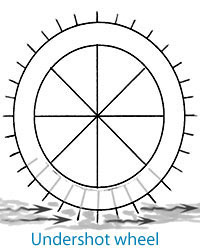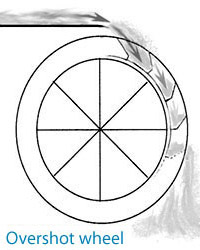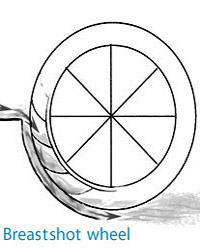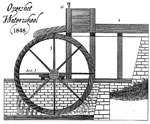
The Three Types of Waterwheels
Jump to:
Introduction |
Images
Introduction
There are three basic types of
waterwheels, each with its own
advantages and disadvantages. Each
type has been in use since at least
Roman times, and remained remarkably
stable from AD500 to the mid-1700s,
when a new type, turbines, began
displacing them, but their heyday is
beyond the time period of this
lesson.
The three types of waterwheels are the horizontal waterwheel, the
undershot vertical waterwheel, and the overshot vertical waterwheel. For
simplicity they are simply known as the horizontal, undershot, and
overshot wheels.
The horizontal waterwheel is the only one that rotates around a vertical
axle (confusing!). The undershot and overshot waterwheels rotate around
a horizontal axle, like a car tire, but as you can see, receive their
driving force from the water at the bottom and top, respectively.
A hybrid of the over- and undershot wheels developed some time in the
later Middle Ages or colonial period as well, but it used the basic
principles of the other two. This was known as the breastshot wheel that
worked somewhat like the undershot wheel, but the water came into
contact with the breastshot wheel at mid-height (i.e., as if it were
hitting us at breast/chest height), and flows down a closely-fitting
housing around the wheel. The wheel therefore partially gets the
advantage of the moving water like the undershot and also the weight of
the falling water, partially like the overshot.
Oliver Evans, considered the father of American millwright work, showed the three types in his 1848 treatise, The Young Mill-Wright and Miller's Guide..
IMAGES
For more on vertical waterwheels, see Pond Lilly Mill Restorations page.
Return to:
One-Minute Essays
 |
|||||||

|





